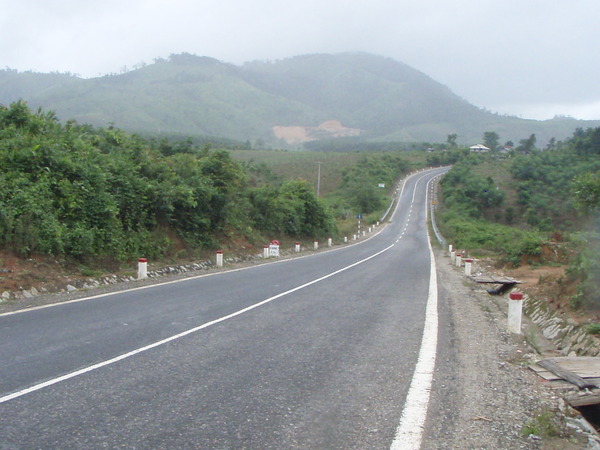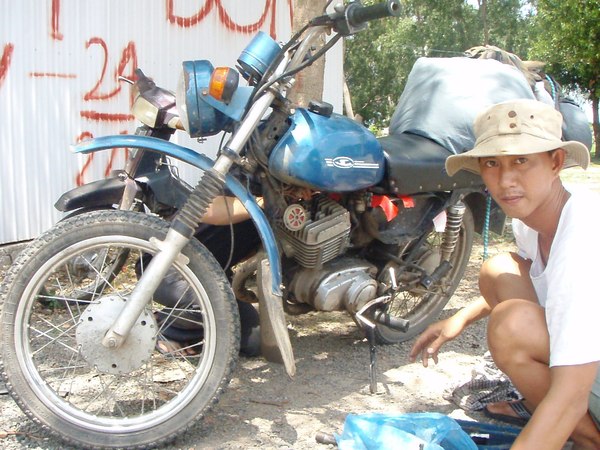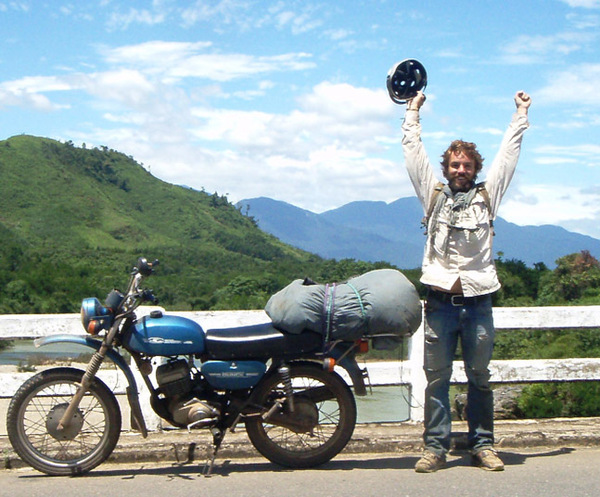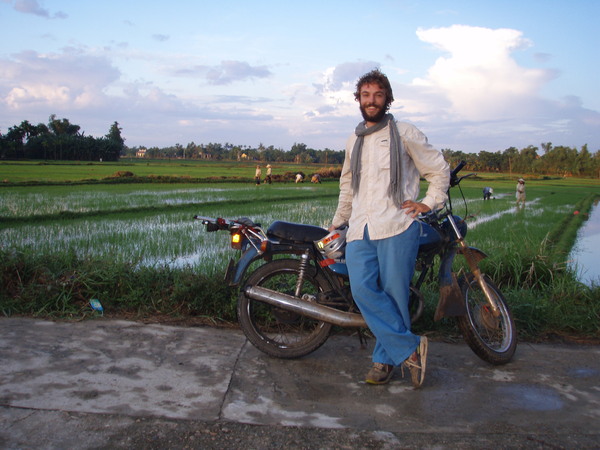
When it comes to Southeast Asia, everyone has the same guidebook and the same itinerary. Chances are you've island hopped through Thailand, trekked through Laos, hit a tranny bar here and there and you still haven't left the crowd behind.
You're stuck on the Banana Pancake Trail. It's time to get off...
You need to do something unique; something everyone else is too scared to do. How about buying a Soviet-made motorbike for $300 and riding it from Saigon to Hanoi? Sound crazy? It is! But you can do it and OTP is well-prepared to guide you through one of the wildest adventures to be had in Southeast Asia.
Step 1: Learn How to Ride
Vietnam is NOT the place to learn how to ride a motorbike. It's dangerous and you must know at least the basics of riding. If you are still stateside, go to the DMV and take a basic safety course for about $250. Warm up to riding in Asia by renting smaller motorbikes in Thailand.
Step 2: Make Some Rough Plans (Pick Your Starting Point)
It makes more sense to start in Hanoi if you are coming from China or northern Laos; Ho Chi Minh City if you are coming from Cambodia. Although Hanoi is an easier place to find a bike, either city will work. Buy the bike in one city, ride it to the other and sell it. Simple.
The north-south journey takes a month. If you are short on time, stick to the north and make the beautiful Hanoi-Dien Bien Phu-Sapa loop. Alternatively, you can seek out the EasyRiders, a local Vietnamese crew, that offers short and long-term tours on the back of their choppers.

Step 3: Pick Your Highway
You don't want to make too many plans in advance. Relax and give yourself the freedom to make up your exact route as you go along. You can choose to follow the coast for the beaches, swing into the misty mountains or carve along jungle valleys, beside waterfalls and through thatched hill-tribe villages. While most of the rides offer a great mix of scenery, there's a fork in the road between Hoi An and Nha Trang.
Take the rural route through Dalat and up into the Central Highlands instead of coastal Highway 1. While Highway 1 connects all the coastal cities in one endless chain of life-threatening traffic, rural roads are usually secluded, peaceful and incredibly scenic. The great north-south rural highway is called the Ho Chi Minh Highway; follow it across almost the entire country. Although there are far less services available along the rural route, the Vietnamese are incredibly warm people and will usually help you however they can. Besides, learning how to get out of such jams puts hair on your chest, don't it?
OTP Tip: When planning your route, remember that rain in the mountains means sun on the beach and vice versa. Also, even when you need to travel along the coast, you can easily hop off Highway 1 and putz along smaller side roads. A great way to learn about the sights along the way is by asking the Easy Rider crew for tips.

Step 4: Find a Bike, and Make it a Minsk
Once you arrive, the first step is to find a bike that won't break the bank. This will require a few days, a bit of tenacity and some bargaining skills.
The Soviet-made Minsk is reliable, simple, durable, can handle all the dirt roads you will inevitably encounter and will carry all your crap through rain and shine. They're also easy to find in both Hanoi and Ho Chi Minh City.
Since you're too broke for a new Minsk (at $700), a used one can be nabbed for $200-$400, depending on how well you bargain.
Search for For Sale flyers in hostels, restaurants, internet cafes and on the street. If you are in Hanoi, swing past the Minsk Club to look for leads. Some people have been lucky and found bikes on the Internet before they even arrived.
Once you find a bike or two, its time to...
Step 5: Bargain Like You Mean Business!
You'll likely buy your Minsk from another backpacker, one who has a month's less money and a month's more experience bargaining like the Vietnamese. You'll need to sit at the bargaining table with some tricks up your sleeve.
Find out the strengths and weaknesses of both you and the seller. His strength lies in the limited supply of bikes -- so the more sellers you can play off each other, the better. His weakness is time and an immediate need for funds to continue traveling. To knock the price down you must find the weaknesses in the bike: point out what's broken, how old it is, anything you can find.
Dance with a few sellers for a bit, then seal the deal over a few pitchers of bia hoi. Play your cards right and he'll buy you all the spare parts you'll need to sweeten the deal. Don't fork over the cash until everything is to your satisfaction.
OTP Tip: You get what you pay for. You may not need a brand-new bike, but you don't necessarily want the cheapest bike you can find. Bargain for a good deal, but make sure the bike you buy will actually make it all the way to Hanoi.

Step 6: Learn The Minsk
Now that you've got your Minsk, lift up her skirt up and see how she works. Tool around the Minsk Club Vietnam website then fine-tune your knowledge with our guide.
OTP Tip: Each Minsk has her own personality, complete with unique quirks. Have the seller explain how to start her when she won't, fix her when she's broke and maintain her along the way. As with everything in nature, the older the bike, the more quirks she'll likely have.
Step 7: Get Some Supplies
You'll need to prepare yourself for this journey. Every rider should carry the tools and supplies he needs to make roadside repairs. Your bike should come with tools. Some extras you will need: spark plugs, chains, spare lights and brake cables.
As for the belongings you already have in your backpack? Shed the junk, keep the basics. You'll have to carry everything on the back of the bike, so keep it lightweight.
Step 8: Tune Her Up
Wheel her to a mechanic for a full rub-down. Make sure the less obvious components are working as well: namely, the horn, brakes and lights. Spy on how the mechanic systematically checks each part of the Minsk and use what you learn as a guide to fixing her up on your own later.
OTP Tip: Once she is fully tuned, you will have to keep her in good condition. Learn about daily maintenance and you will save yourself a lot of breakdowns.

Step 9: Rules of the Road
You're almost ready to take off. The streets of Hanoi might seem like a massive traffic jam, but don't stress -- there's a method to the madness. Here' s the breakdown:
Might is right. Big trucks and tourist buses dominate the center of the road, normal trucks and cars are in the middle and motorcyclists are on the shoulder. Passing is the norm in Vietnam and even the semi-trailers will swing into the opposite lane to pass someone. Stay alert.
Typically you drive your bike until you approach another driver from the rear, then honk twice as a friendly signal and pass them on the left side. Repeat all day.
OTP Tip: Getting out of the cities can be the hardest bit. Warm up by hiring a motorcycle taxi and riding around the city to get a feel for the flow of traffic. Repeat until you feel comfortable enough to take off. There is no shame in paying a motorcycle taxi driver $5 to guide you to the outskirts of the city on your first day.
Step 10: Take Off and Let Go
You now have freedom from itineraries, fixed bus schedules and group tours; you can go anywhere and stop as long as you like. Just you, the Minsk and the road.
- Slow down. As you plan out each leg of the journey, reign in your ambitions. Remember that you are no longer traveling by bus: Driving a motorbike is physically exhausting. You feel every last mile and you are always at the mercy of the weather. The roads are windy, slow and not always paved.
- Bring yourself into the moment. The constant fear that death lurks around each corner strips away all your distant concerns and brings you to the here and now. You may never do something like this again, so make sure your mind is fully appreciating it and not off in the clouds.
- Accept setbacks and delays with a smile. When breakdowns happen on the road -- and they will -- learn to embrace them as a chance to slow down and pause in a part of Vietnam you normally would have sped past. Take five minutes to admire the view of the jungle before getting down to work. Remember, delays don't exist. You have nowhere to be but here, in the moment. Smile.
- Open yourself to the endless possibilities of the road. Take as many detours as you like. Check out the small villages, take the road that isn't on your map and accept the offers to have tea with local families. Vietnamese visas typically last one month, but you are free to extend yours and stay another month or two. And, rumor has it, if you carry enough US dollars, you might be able to use some baksheesh to illegally sneak your bike into Cambodia or Laos.
- Stick it to Mass Tourism. By taking this bike ride on your own, you have circumvented the middleman between you and your host country. As you journey farther into the misty mountains and away from the tourist trail, you will transcend mass tourism and encounter a more fundamental human relationship with your host country. Differences in nationality, beliefs, age and income will disappear. While other backpackers are paying $20 a night for "authentic homestays," your entire journey will transform into one enormous authentic experience.
As you pull away from Saigon, you'll taste true freedom. As you chase the sunset along Vietnam's golden coastline, you'll arrive in the present moment. As you slip into top gear and rip alongside endless fields of rice paddies, you'll discover what it feels like to be young and alive. That is, of course, how we should feel all the time. But sometimes it takes a bit of old-fashioned adventure to remind us.
-- Mark Ayling